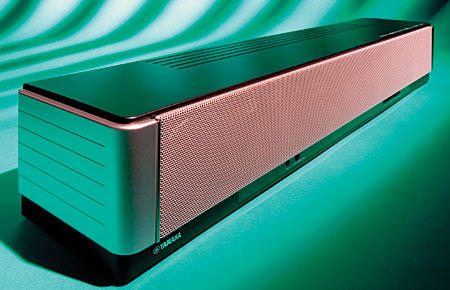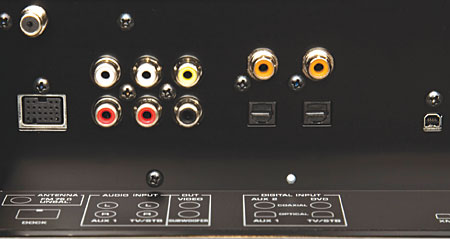The Power of One: Five Soundbar Speaker Systems Yamaha YSP-3000
While other audio companies are just entering the soundbar market, Yamaha is on their third generation of digital sound projectors. The new YSP-3000 falls in the middle of the third-generation lineup, between the $1,800 YSP-4000 and the $900 YSP-900. This is yet another active system with its own amplification and a connection panel that looks more like a receiver than a speaker: two HDMI inputs, one HDMI and composite video output, four digital audio inputs (two optical, two coaxial), two stereo analog inputs, a 3.5mm aux input, and a subwoofer preout to connect an optional subwoofer like the Polk PSW111 we used. As with the Marantz model, the HDMI inputs are passthrough only and can accept both 1080p/24 and 1080p/60, but you can’t reassign inputs to obtain video through HDMI and audio through optical or coaxial. The system is XM ready, and it includes an FM tuner, an IR port, and a control port for the optional $80 YDS-10 iPod dock.

At just 31.5 inches long, the YSP-3000 was the shortest soundbar in the test, but it’s also quite boxy. Scott wasn’t a fan of the bulk or the two-tone silver/black design, commenting that it looked like an industrial-sized toaster (an all-black version is also available). To me, the YSP-3000 looks more like a component than a speaker, and its narrower width would make it possible to place the bar in a wider equipment rack. Yamaha doesn’t supply wall brackets or a tabletop base, but optional wall brackets are available.

In addition to Dolby Digital, DTS, and Dolby Pro Logic II Music/Movie sound modes, the YSP-3000 offers DPL II Game and DTS Neo:6 Cinema/Music, as well as Neural Surround for XM and the various Cinema DSP sound modes included in a Yamaha receiver. The supplied remote is chock-full o’ buttons, further reflecting the system’s receiver-like nature. It lacks backlighting, but it can control up to five additional components.
 The YSP-3000 is the only soundbar in the Face Off that offers an automatic setup and calibration process, using the supplied IntelliBeam microphone. The system automatically detects the subwoofer, analyzes your room, and adjusts the crossover, speaker levels, and soundfield simulation accordingly. You don’t need to see the YSP-3000’s onscreen display to perform this, which is good since the display is only available through the composite video output. You can save three different setups for different room environments. You can also manually adjust the sub/speaker level, distance, delay, and crossover, as well as the soundbar position, amount of room reflection, and precise trajectory of the beams. For the Face Off, I stuck with the auto-setup results, but I did turn down the subwoofer level, which was set way too loud compared with the speakers.
The YSP-3000 is the only soundbar in the Face Off that offers an automatic setup and calibration process, using the supplied IntelliBeam microphone. The system automatically detects the subwoofer, analyzes your room, and adjusts the crossover, speaker levels, and soundfield simulation accordingly. You don’t need to see the YSP-3000’s onscreen display to perform this, which is good since the display is only available through the composite video output. You can save three different setups for different room environments. You can also manually adjust the sub/speaker level, distance, delay, and crossover, as well as the soundbar position, amount of room reflection, and precise trajectory of the beams. For the Face Off, I stuck with the auto-setup results, but I did turn down the subwoofer level, which was set way too loud compared with the speakers.
Yamaha takes the least traditional driver approach, packing 21 tiny 1.56-inch drivers and two slightly larger 3.94-inch woofers into that small chassis. You can choose between four beam arrays that employ different types of acoustic manipulation depending on the kind of surround envelopment you desire. We all agreed that this multi-driver approach is capable of offering the most realistic surround simulation, but it was highly dependent on room conditions. I spent most of the Face Off at the back of the room. In the chaotic battle sequence from Lord of the Rings, rushing arrows seemed to fly off to the sides in a more believable way than the other soundbars created. Scott also commented that the effects were “corner-dependent” and, thus, better off to the sides. Dano and Johnny thought that the side surround effects worked better with the speaker placed higher on the wall. When I later moved to the center sweet spot, I experimented with the beam trajectories and successfully pulled the reflections in toward the seating area; it’s great that you can make these precise adjustments. But will a person who’s reluctant to run speaker cable really want to adjust beam trajectories?
Several panelists commented that sound cues weren’t always located where they belonged, that the soundstage seemed muddy. In describing the swirling effects of Underworld, Johnny said the Yamaha created a “cloud of sound instead of distinct effects.” Having heard these demos endless times, I also felt that some of the more subtle sound cues were buried amidst the chaos. Even with two-channel music, Scott felt that the YSP-3000 didn’t exhibit good stereo imaging.
Given the drivers’ small size, the midrange was somewhat lean, and individual sounds, like the orchestral instruments in the Immortal Beloved demo, sounded a bit constrained. High-frequency effects were generally smooth, although they broke up at higher volumes. You’ll definitely want to mate the YSP-3000 with a subwoofer, and the Polk proved to be a good companion. Even with it, though, Johnny felt that he got the highs and lows but “lost the mid strings” in the music tracks. Finally, the YSP-3000’s dynamic ability wasn’t as good as the other soundbars in my medium-sized room.
As I mentioned, the rankings for the Marantz, Yamaha, and Denon models were quite close. The YSP-3000 was Dano’s second favorite system, due to its good surround simulation. Ultimately, however, this model landed in fourth place for performance, but the thorough features package bumped it up to third overall. I think the YSP-3000 is a better fit for the slightly more advanced user who wants more control over the experience: video switching, more sound modes and setup options, and the ability to precisely tweak the surround soundfield in ways the average user probably wouldn’t.




























































